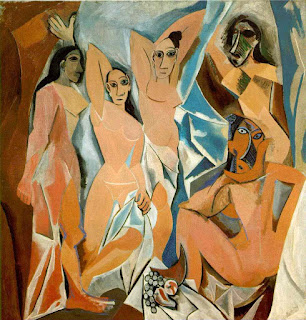 As an art historian, I’ve always been interested in Hegel’s concept of the Geist. For those of you unfamiliar with Hegel, he was an 18th/19th century philosopher who believed that there was a “world spirit” that manifested itself in art, religion, and philosophy. The Geist continues to develop and evolve throughout history; essentially, due to the Geist (almost as a type of driving force for the history of the world), things develop and evolve at the time and rate that they are supposed to.
As an art historian, I’ve always been interested in Hegel’s concept of the Geist. For those of you unfamiliar with Hegel, he was an 18th/19th century philosopher who believed that there was a “world spirit” that manifested itself in art, religion, and philosophy. The Geist continues to develop and evolve throughout history; essentially, due to the Geist (almost as a type of driving force for the history of the world), things develop and evolve at the time and rate that they are supposed to.
One reason why Hegel is important to art history is because of his classification and discussion of how art has developed. Hegel found that art developed in three stages: Symbolic (prehistoric, Egyptian), Classical (Greek), and Romantic (post-Classical, i.e., Christian). In this final Romantic phase, Hegel discusses how art has become spiritualized in nature. Had Hegel lived into the early 20th century, I wonder if he would have added an additional phase which could have focused on formalism.
I began thinking about the concept of Geist and the 20th century last night on a walk with J. He was telling me about his music history lecture which focused on the 20th century composer, Schoenberg. Although Schoenberg was friends with expressionistic painters and dabbled in expressionistic painting himself, his explorations in atonal music (particularly his development of a twelve-tone method) indicate his interest in formalism. Schoenberg felt that this evolution from tonal to atonal was a natural development for music.1
Perhaps a musical or formalist Geist was driving this change in music. Schoenberg began dabbling in atonality in 1908. That same year, independently of Schoenberg, a Russian composer (and synesthete, Katherine!) named Scriabin also broke with tonality.2
The thing I find so fascinating about these formalistic changes in music is that the same thing happened art historically. In 1907-08 (note the date again!), Picasso created “Les Demoiselles D’Avignon,” the seminal early Cubist painting which revolutionized the meaning and creation of art. The Cubist style, with the breaking down and exploration of forms, is also formalist in nature. Even the flatness associated with the Cubist style is a recognition of the flat form of the canvas – a flatness which artists tried to escape or deny with illusionistic art that began in the Renaissance.
Doesn’t it seem like the Geist was bringing about these artistic and musical changes in the early 2oth century? I wonder if Hegel would think so…
1 Schoenberg said, “I am convinced that eventually people will recognize how immediately this ‘something new’ is linked to the loftiest models that have been granted us. I venture to credit myself with having written truly new music which, being based on tradition, is destined to become tradition.” (See J. Peter Burkholder, Donald J. Grout and Claude V. Palisca, A History of Western Music, 7th ed., (New York: W. W. Norton and Company, 2006, 804). It is also interesting to note that Schoenberg was against using the term “atonal.” He said, “The word ‘atonal’ could only signify something entirely inconsistent with the nature of tone. . . . [T]o call any relation of tones atonal is just as farfetched as it would be to designate a relation of colors aspectral or acomplementary. There is no such antithesis.” (See Arnold Schoenberg, Theory of Harmony, translated by Roy Carter, (Berkeley & Los Angeles: University of California Press, 1978, 432)). Therefore, it appears that Schoenberg did not feel like he was “going against” anything musical with his usage of tones.
2 This information was given in J’s lecture, so I can’t cite a specific source. It appears that his “Poem of Ecstasy” was written in 1908, so this may be the work to which J’s teacher referred. I will need to do a little more research though. From what I have found on this less-credible source, however, Scriabin began working on atonality from 1903-08. Even if this was the case, the close connection between Scriabin and Schoenberg’s interests in atonality can still fit into this idea of Geist. It would just be cooler if it all happened in 1908.
These clouds immediately reminded me of paintings by Morris Louis. Louis was a color field painter from the 1950s and 1960s. His paintings typically were created out of extremely thinned paint that was poured over an unprimed canvas. To give you an idea of the effect of Louis’ technique, here’s his painting, “Point of Tranquility,” (1959-1960).




